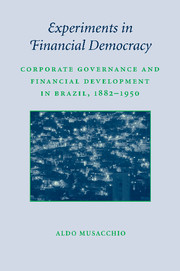 Experiments in Financial Democracy
Experiments in Financial Democracy Book contents
- Frontmatter
- Contents
- List of Figures and Tables
- Preface
- Acknowledgments
- 1 Introduction
- 2 Financial Development in Brazil in the Nineteenth Century
- 3 The Stock Exchange and the Early Industrialization of Brazil, 1882–1930
- 4 The Foundations of Financial Democracy: Disclosure Laws and Shareholder Protections in Corporate Bylaws
- 5 Voting Rights, Government Guarantees, and Ownership Concentration, 1890–1950
- 6 Directors, Corporate Governance, and Executive Compensation in Brazil, c. 1909
- 7 Bond Markets and Creditor Rights in Brazil, 1850–1945
- 8 Were Bankers Acting as Market Makers?
- 9 What Went Wrong after World War I?
- 10 The Rise of Concentrated Ownership in the Twentieth Century
- 11 Conclusion
- Bibliography
- Index
- STUDIES IN MACROECONOMIC HISTORY
3 - The Stock Exchange and the Early Industrialization of Brazil, 1882–1930
Published online by Cambridge University Press: 30 January 2010
- Frontmatter
- Contents
- List of Figures and Tables
- Preface
- Acknowledgments
- 1 Introduction
- 2 Financial Development in Brazil in the Nineteenth Century
- 3 The Stock Exchange and the Early Industrialization of Brazil, 1882–1930
- 4 The Foundations of Financial Democracy: Disclosure Laws and Shareholder Protections in Corporate Bylaws
- 5 Voting Rights, Government Guarantees, and Ownership Concentration, 1890–1950
- 6 Directors, Corporate Governance, and Executive Compensation in Brazil, c. 1909
- 7 Bond Markets and Creditor Rights in Brazil, 1850–1945
- 8 Were Bankers Acting as Market Makers?
- 9 What Went Wrong after World War I?
- 10 The Rise of Concentrated Ownership in the Twentieth Century
- 11 Conclusion
- Bibliography
- Index
- STUDIES IN MACROECONOMIC HISTORY
Summary
The estimates of stock and bond market capitalization presented in the previous chapter reveal that the development of these markets enjoyed a significant period of activity during the three decades from 1882 to 1913, but not whether that development mattered for Brazil. This chapter argues that this first peak of stock market activity had a considerable impact on Brazil's transformation into a more urbanized, industrialized economy.
At the end of the nineteenth century Brazil was still predominantly an agricultural economy. Most of the population lived in rural areas and worked in agriculture or in activities related to agriculture. Therefore this chapter describes not only the rise of equity and bond markets, but also the beginning of the transformation of Brazil from an agricultural economy to a more urbanized society with a larger proportion of the population working in manufacturing and services. It shows that the stock exchange helped to mobilize resources for emerging sectors (e.g., manufacturing, utilities, and urban improvements), which accelerated the rate of urbanization, industrialization, and, ultimately, economic growth.
The last decade of the nineteenth century was particularly important for the transformation of the country into a more industrialized society. Slavery was abolished in 1888 and European immigrants were imported en masse after the 1880s. With state-sponsored programs to bring immigrants from southern Europe to work at coffee plantations and in urban manufacturing centers, wage labor markets changed significantly, especially in the intererior of the country.
- Type
- Chapter
- Information
- Experiments in Financial DemocracyCorporate Governance and Financial Development in Brazil, 1882–1950, pp. 58 - 83Publisher: Cambridge University PressPrint publication year: 2009
